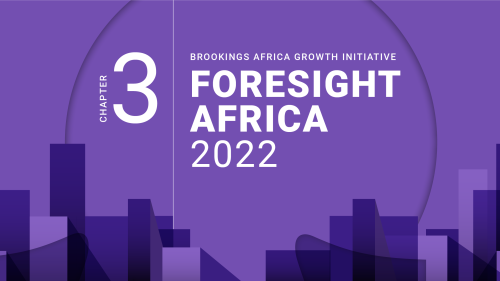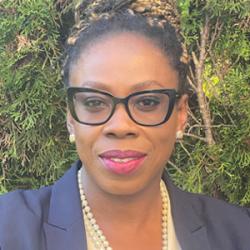Below is a governance viewpoint from the Foresight Africa 2022 report, which explores top priorities for the region in the coming year. Read the full chapter on African women and girls.
 Women’s equal participation in government is central to democracy and achieving sustainable development and egalitarian societies. While the struggle to redress the marginalization of women in leadership positions show a measure of success, this progress has been slow and uneven since 1995. Gender disparity persists in access to political leadership across local governments, national parliaments, and executive institutions of power—despite and in violation of an array of global, regional, and national laws that invest women with rights to equal political participation and representation as citizens. Women also face significant disparities within political parties, who serve as the gatekeepers to women’s political access and competitiveness. For example, in Africa, 24 percent of national parliamentarians and 21 percent of local government leaders are women. The continent also ranks far below the global average of 20 percent for women ministers in national cabinet positions.
Women’s equal participation in government is central to democracy and achieving sustainable development and egalitarian societies. While the struggle to redress the marginalization of women in leadership positions show a measure of success, this progress has been slow and uneven since 1995. Gender disparity persists in access to political leadership across local governments, national parliaments, and executive institutions of power—despite and in violation of an array of global, regional, and national laws that invest women with rights to equal political participation and representation as citizens. Women also face significant disparities within political parties, who serve as the gatekeepers to women’s political access and competitiveness. For example, in Africa, 24 percent of national parliamentarians and 21 percent of local government leaders are women. The continent also ranks far below the global average of 20 percent for women ministers in national cabinet positions.
Arguments for women’s equal leadership participation in politics have highlighted its intrinsic value and instrumental justifications. Its fundamental goal—articulated within claims of democratic justice, equity and human rights—is expressed in the multiple international agreements, regional frameworks, and national laws driven by women’s movements and feminists’ mobilizations. The instrumental rationale centers on arguments of the policy-responsiveness of political representatives towards those they represent. Specifically, it supports the expectations that women’s presence in political leadership will lead to inclusive decisions that reflect the needs and interests of a broader population, including women and girls. In effect, women’s political leadership results in optimal governance outcomes for most of society.
While there is no shortage of intelligent, ambitious, and capable African women potential leaders, multiple obstacles hinder women’s leadership aspirations and candidacy.
While there is no shortage of intelligent, ambitious, and capable African women potential leaders, multiple obstacles hinder women’s leadership aspirations and candidacy. These barriers are determined by contextual factors that combine formal and informal rules, institutions and other structural elements in unique ways to limit women’s access to power as they shape opportunities and incentives for actors and actions.
Although unwritten, informal rules string together expectations from culture, religion, and social structures to exert powerful constraints on women’s political agency alongside formal institutions. These structural and cultural barriers, including those of tradition, impose significant limitations on women’s access to resources, and place high demands on their time as gender roles increase their responsibility of care in the home, thus creating vast resource and time deficits that benefit men and curtail opportunities of entry and electoral victory for women.
Women’s equal participation is also impeded by conscious and unconscious biases, discriminatory attitudes and norms, and mobility limitations due to threats of (political) violence that continue to pose obstacles to meaningful leadership participation of women within state institutions.
Records of previous and ongoing interventions provide evidence of numerous effective strategies for advancing women’s political participation across the region. Thus, I suggest four key policy areas decisionmakers might prioritize for promoting gender equality in political leadership, particularly in the coming year.
The starting point must be the transformation of formal, political institutions through constitutional amendments, legal reforms, and targeted affirmative action programs, including but not limited to legislated sex quotas, reservations, and party mandates when combined with adequate safeguards. Political parties must be key targets for transformation as they are central to women’s political access and competitiveness. Their provision, or not, of a fair playing ground directly impacts women’s access to appointed and elected positions in government.
Second, capacity-building interventions for women political leaders within established women parliamentary caucuses provide women leaders with skills and knowledge for effectiveness and success. Meaningful (substantive) representation from women leaders, or the perception thereof, reinforces role-modeling effects and meets voters’ demand for performance accountability, which increases public’s positive attitude and support for women’s political leadership. Training should focus on key actors—gatekeepers and influencers, leadership models and networks, and understanding strategic influence and effective forms of social action for change.
Third, interventions towards promoting social mobilization and collective action contributes to changes in the nature of the state and expands space for women’s inclusion. While these changes can be progressive, they could also advance a conservative agenda like religious and ethnicity-based civil society mobilizations. Policy entrepreneurs and implementers should be vigilant, therefore, in ensuring that, when mobilized, these coalitions and movements are not hijacked and used to promote myriad agendas that mask closet anti-gender propositions, including traditional notions of women’s subjecthood that limits their opportunities for political leadership.
Finally, promoting a conducive and gender-inclusive society constitutes an important variable in the tension between positive changes in women’s leadership participation and persistent sexist attitudes.
Finally, promoting a conducive and gender-inclusive society constitutes an important variable in the tension between positive changes in women’s leadership participation and persistent sexist attitudes. Gender norms and behaviors have shaped women’s experience in running for and holding political offices. For those women who are elected, norms also shape their leadership experience, including how they are perceived and treated by the public and by fellow political actors. Inequalities emanating from social discrimination are reflected in informal rules, which require more deep-seated structural reconfiguration. Interventions that aim to correct these norms can become catalysts for change. In the long term, exposure to female leadership can also alter social norms. While norms and social attitudes change in modest increments over long periods, interventions targeting traditional and regressive gender norms have been known to promote conducive and gender-inclusive societies.
The relationship between political change and social change is complex. Political change is nothing if there is no social change in the way men perceive women, and political change might be inaccessible without social change. As such, ensuring social change can guarantee political change, including equal women’s political representation across formal bodies of the state.
As we contemplate the new year, we don’t start from nothing; we have lessons on which to build. In fact, the COVID-19 pandemic highlighted two simultaneous and contrasting patterns in its impact on gender equality in general and specifically, women’s political leadership. On the one hand, it spotlighted the fragility of progress on gender equality, evidenced in the stunning reversal of gains made over decades in just two years. On the other hand, it highlighted that inclusive politics provides a template for effective governance while women’s equal political participation offers pathways for policy change by establishing stronger social nets and systems for more resilient societies. The future is equal.






Commentary
Priorities for advancing women’s equal political leadership in the coming year
February 23, 2022